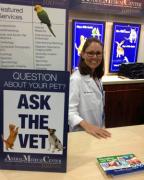Meet the Breeds: Ask a Question

Meet the Breeds: Ask a Question
During the last weekend of September, The Animal Medical Center staffed an information booth at the American Kennel Club’s annual Meet the Breeds Show at New York City’s Jacob Javits Center. I spent several hours answering questions from pet owners on Sunday afternoon. The questions were important ones for all pets, so I decided to share my answers with everyone through The AMC blog.
Are caterpillars toxic?
A concerned dog owner found her dog snacking on the big, furry caterpillars that had invaded the potted plants on her terrace. Certain insects can injure pets if they are venomous, like wasps or bees. Most caterpillars are not venomous and are not listed as toxic on Animal Poison Control or Pet Poison Hotlines' websites. Although Survivorman eats caterpillars, the hairs on the skin of certain ones can be very irritating and for me, just thinking about a dog swallowing these hairy little creatures makes me gag. It is best not to let your dog (or cat) eat caterpillars, but consumption of one or two probably carries a low level of risk.
Is a one hour walk a day enough for my older dog?
Just like your doctor recommends you practice a well-rounded fitness routine, your dog needs more than a walk on a nice flat street. The Mayo Clinic recommends exercise include aerobic fitness, muscular fitness, stretching, core exercise and balance training. Challenge your dog by walking up and down hills. Be sure to include games like fetch to encourage your dog to run to increase her heart rate. Don’t forget to include stairs as part of your dog’s routine. For stretching and balance fitness, view The AMC’s exercise tips for dogs.
My 7 month old Chihuahua has a pink lump that comes and goes in the corner of his eye. Is this serious?
Without seeing this dog, I can only speculate as to what the problem is. However, I am guessing the dog has a condition veterinarians call “cherry eye.” Cherry eye is the tear gland from the third eyelid, an important source of tears to keep your dog’s eyes moist, and it occurs most commonly in Cocker Spaniels and English Bulldogs. The AMC’s ophthalmologist, Dr. Alexandra van der Woerdt recommends the gland be tacked back into place during a minor surgical procedure to preserve its function. The cause of cherry eye is suspected to be a weakness in the ligament that holds the gland in place.
My dog woke up one morning and couldn't walk, so I gave him some of my medications and now he’s better. Should I keep giving the pills?
The answer to this question is not about pills but about the need to see your veterinarian to get pet-safe prescriptions. Every year, thousands of dogs and cats are sickened from accidental ingestion or purposeful administration of human medications. Veterinarians do sometimes prescribe human medications for dogs and cats, but you should never give your pet any medications without clearing it through your veterinarian first.

































